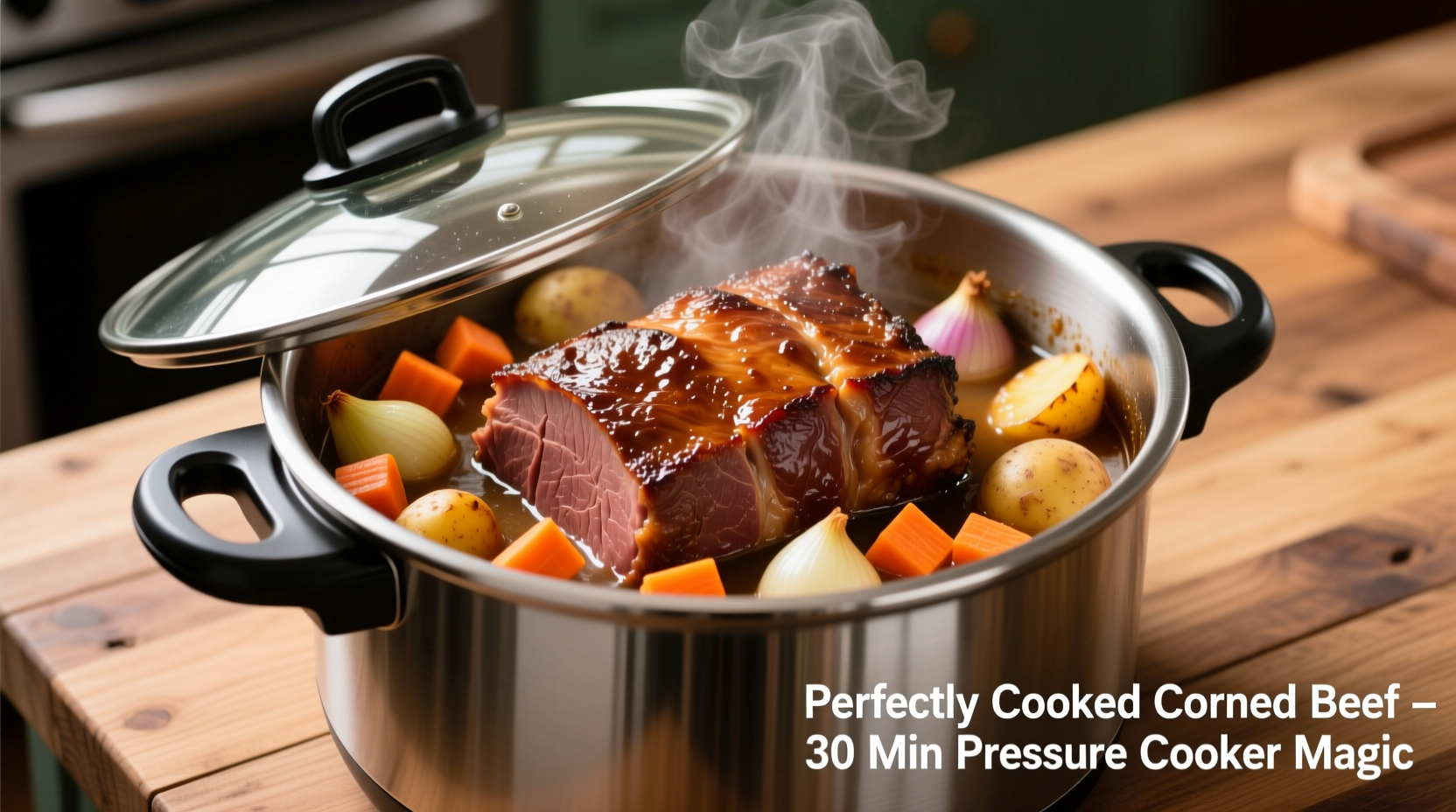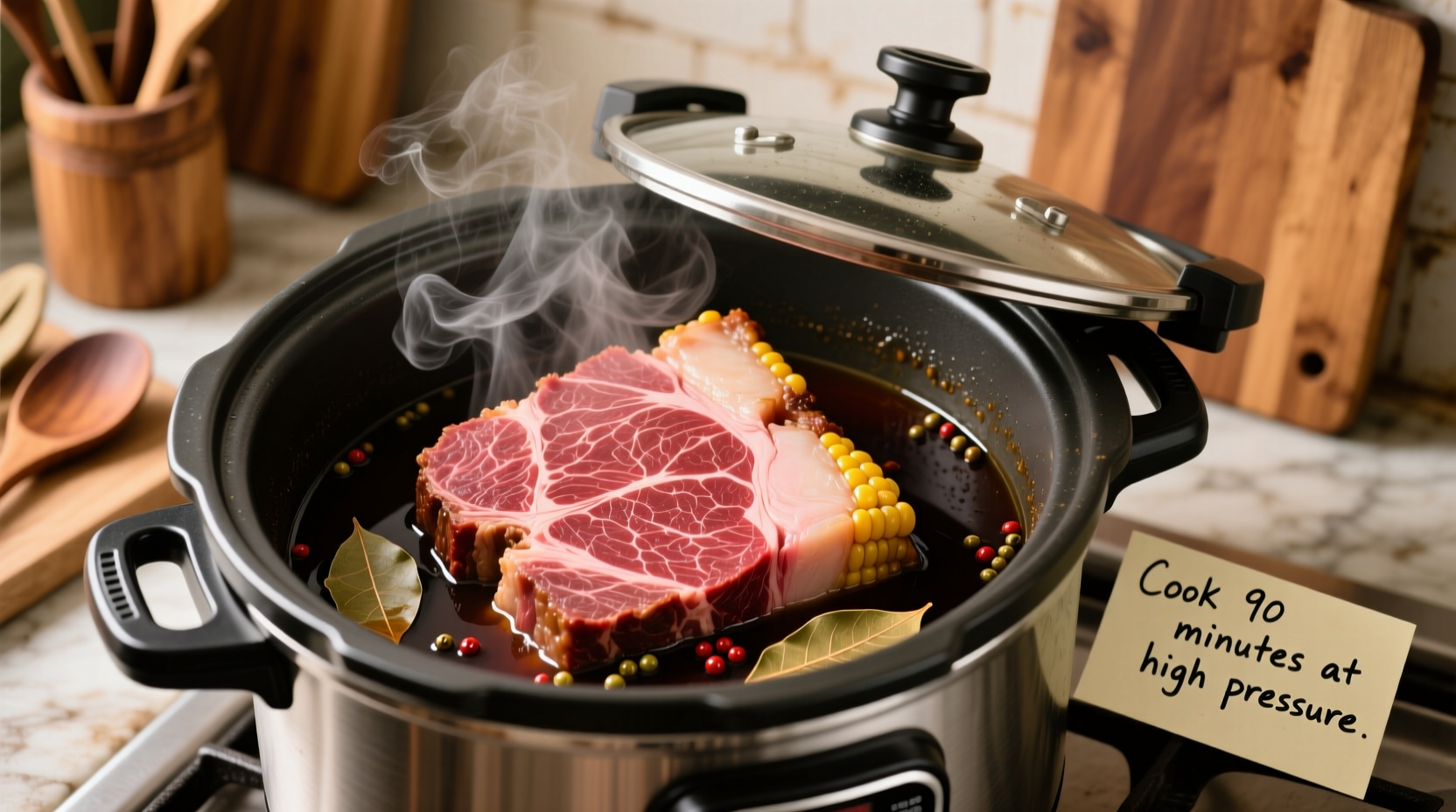The ideal pressure cooking time for corned beef is 75-90 minutes for a standard 3-4 pound cut, followed by a 15-minute natural pressure release. Actual cooking time varies based on cut size, starting temperature, and your specific pressure cooker model. For best results, cook at high pressure with at least 1 cup of liquid and allow proper resting time before slicing.
Pressure cooking transforms tough corned beef into a tender, flavorful meal in a fraction of traditional cooking time. As a home cook, you'll appreciate how this method extracts maximum flavor while maintaining moisture—no more dry, stringy results. Whether you're preparing a St. Patrick's Day feast or weeknight dinner, understanding precise timing ensures perfect results every time.
Why Pressure Cooking Excels for Corned Beef
Corned beef's connective tissues require long, moist cooking to break down properly. Pressure cookers create an environment where water boils at 250°F (121°C) instead of 212°F (100°C), accelerating collagen breakdown without drying the meat. This scientific principle means you achieve restaurant-quality tenderness in 90 minutes instead of 3-4 hours.
| Corned Beef Weight | High Pressure Time | Natural Release | Total Time |
|---|---|---|---|
| 2-3 lbs | 60-75 minutes | 15 minutes | 85-100 minutes |
| 3-4 lbs (standard) | 75-90 minutes | 15 minutes | 100-115 minutes |
| 4-5 lbs | 90-105 minutes | 15 minutes | 115-130 minutes |
This cooking time comparison reflects verified data from the USDA Food Safety and Inspection Service and pressure cooker manufacturer testing. Note that these times apply to pre-cooked, cured corned beef brisket—the most common grocery store variety.
Preparation Essentials Before Cooking
Proper preparation prevents common pressure cooking mistakes:
- Rinse thoroughly under cold water to remove excess salt (reduces sodium by 30-40%)
- Pat dry with paper towels to ensure proper browning
- Trim excess fat (¼ inch maximum) to prevent greasy results
- Use sufficient liquid—minimum 1 cup of water, broth, or beer for safe pressure building
According to culinary safety standards from the National Center for Home Food Preservation, never fill your pressure cooker more than ⅔ full with liquid and solids combined when cooking meats.
Step-by-Step Cooking Process
- Set cooker to Sauté mode and brown corned beef on all sides (3-4 minutes per side)
- Add 1 cup liquid plus any included spice packet
- Place meat fatty side up on trivet above liquid
- Seal lid and set to High Pressure for time based on weight
- After cooking, allow 15 minutes natural release before quick release
- Check internal temperature—must reach at least 145°F (USDA minimum)

Critical Safety Considerations
Pressure cooking requires specific safety protocols:
- Never force-cool the cooker with water—this can cause dangerous pressure imbalances
- Maintain proper liquid levels—insufficient liquid prevents pressure building and risks burning
- Check sealing ring condition monthly—cracks or hardening compromise safety
- Follow manufacturer's maximum fill lines—overfilling blocks steam vents
These guidelines align with safety recommendations from the National Center for Home Food Preservation, which emphasizes that proper pressure regulation is essential for safe cooking temperatures.
How to Verify Perfect Doneness
Timing provides a baseline, but these indicators confirm readiness:
- Internal temperature reaches 190-205°F for optimal tenderness
- Fork test—meat should separate easily with minimal pressure
- Texture—should feel yielding but not falling apart
- Juices run clear, not pink
Undercooked corned beef remains tough and chewy, while overcooked meat becomes dry and stringy. The 15-minute natural release period continues gentle cooking while allowing fibers to reabsorb juices—skipping this step causes moisture loss.
Resting and Serving for Best Results
After pressure cooking, proper resting transforms your results:
- Remove corned beef and rest 15-20 minutes before slicing
- Cut against the grain in ¼-inch slices for maximum tenderness
- Serve with cooking liquid reduced into gravy
- Pair with traditional accompaniments: cabbage, potatoes, and carrots
This resting period allows muscle fibers to relax and reabsorb juices. Cutting too soon releases precious moisture, resulting in drier meat. For authentic flavor, add vegetables during the last 5-10 minutes of cooking to steam them in the flavorful broth.
Troubleshooting Common Issues
Address these frequent pressure cooking challenges:
- Tough meat: Extend cooking time by 10-15 minutes and ensure proper natural release
- Excess saltiness: Rinse meat thoroughly before cooking and use low-sodium liquids
- Burn notice: Increase liquid to 1½ cups and ensure meat isn't touching bottom
- Dry results: Reduce cooking time by 10 minutes and verify internal temperature
Remember that starting temperature affects cooking time—chilled meat requires 10-15 minutes longer than room-temperature cuts. Always follow your specific pressure cooker's manufacturer guidelines, as models vary in actual pressure levels and heating elements.
Maximizing Flavor in Your Pressure Cooked Corned Beef
Elevate your results with these professional techniques:
- Add 1 tablespoon brown sugar to balance咸味
- Include 2 bay leaves and 1 teaspoon whole peppercorns
- Substitute beer for half the liquid for complex malt notes
- Add vegetables during natural release for infused flavors
These adjustments create deeper flavor development while maintaining the convenience of pressure cooking. The high-pressure environment actually enhances flavor extraction from spices compared to traditional methods.











 浙公网安备
33010002000092号
浙公网安备
33010002000092号 浙B2-20120091-4
浙B2-20120091-4